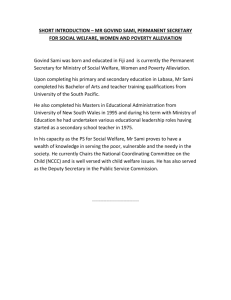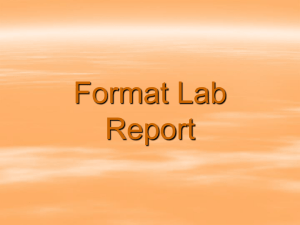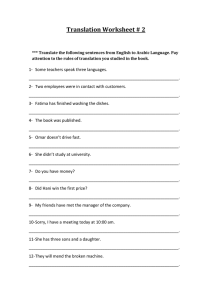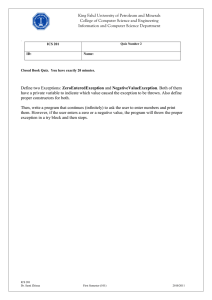NORWAY
advertisement
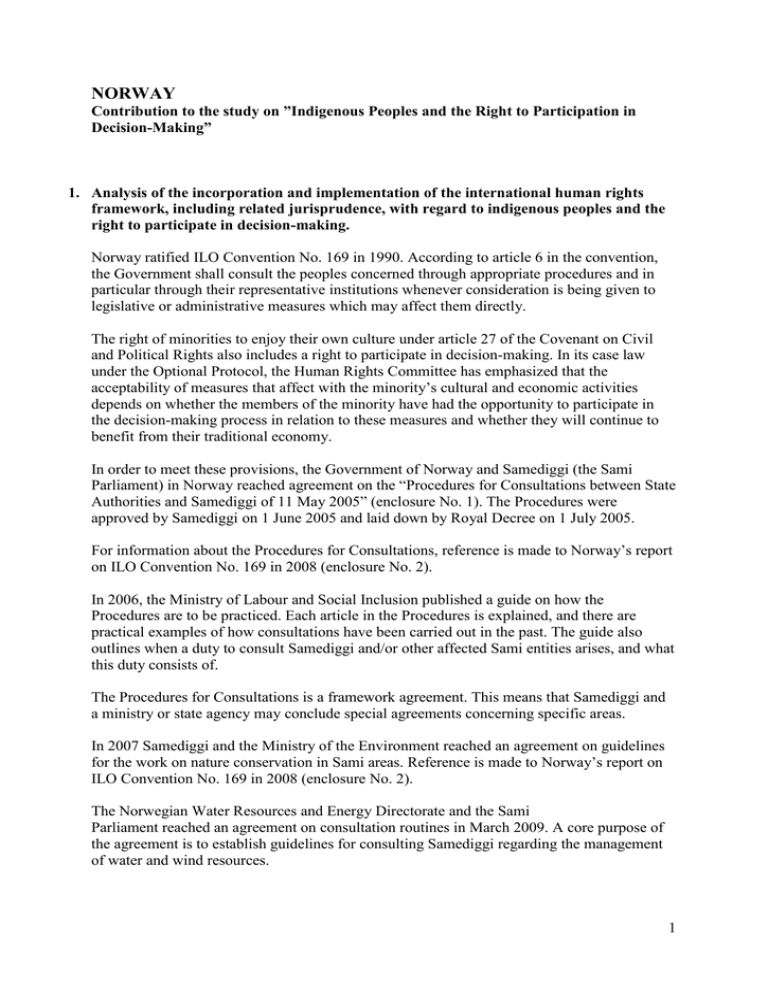
NORWAY Contribution to the study on ”Indigenous Peoples and the Right to Participation in Decision-Making” 1. Analysis of the incorporation and implementation of the international human rights framework, including related jurisprudence, with regard to indigenous peoples and the right to participate in decision-making. Norway ratified ILO Convention No. 169 in 1990. According to article 6 in the convention, the Government shall consult the peoples concerned through appropriate procedures and in particular through their representative institutions whenever consideration is being given to legislative or administrative measures which may affect them directly. The right of minorities to enjoy their own culture under article 27 of the Covenant on Civil and Political Rights also includes a right to participate in decision-making. In its case law under the Optional Protocol, the Human Rights Committee has emphasized that the acceptability of measures that affect with the minority’s cultural and economic activities depends on whether the members of the minority have had the opportunity to participate in the decision-making process in relation to these measures and whether they will continue to benefit from their traditional economy. In order to meet these provisions, the Government of Norway and Samediggi (the Sami Parliament) in Norway reached agreement on the “Procedures for Consultations between State Authorities and Samediggi of 11 May 2005” (enclosure No. 1). The Procedures were approved by Samediggi on 1 June 2005 and laid down by Royal Decree on 1 July 2005. For information about the Procedures for Consultations, reference is made to Norway’s report on ILO Convention No. 169 in 2008 (enclosure No. 2). In 2006, the Ministry of Labour and Social Inclusion published a guide on how the Procedures are to be practiced. Each article in the Procedures is explained, and there are practical examples of how consultations have been carried out in the past. The guide also outlines when a duty to consult Samediggi and/or other affected Sami entities arises, and what this duty consists of. The Procedures for Consultations is a framework agreement. This means that Samediggi and a ministry or state agency may conclude special agreements concerning specific areas. In 2007 Samediggi and the Ministry of the Environment reached an agreement on guidelines for the work on nature conservation in Sami areas. Reference is made to Norway’s report on ILO Convention No. 169 in 2008 (enclosure No. 2). The Norwegian Water Resources and Energy Directorate and the Sami Parliament reached an agreement on consultation routines in March 2009. A core purpose of the agreement is to establish guidelines for consulting Samediggi regarding the management of water and wind resources. 1 There is no formalized framework for dialogue between Samediggi and municipalities or counties. However, several counties have entered into political collaboration agreements with Samediggi. 2. Identification of indigenous peoples’ own decision-making processes and institutions as well as challenges in maintaining and developing them. Samediggi (the Sami Parliament) Samediggi in Norway is elected through general elections by and among the Sami in the country. It is an independent political organ and the highest representative body of the Sami in Norway. The legal basis for establishing Samediggi is found in section 1-2 of the Sami Act, which states that the Sami shall have their own national Sami Parliament elected by and amongst the Sami in Norway. The establishment of Samediggi is a core element in the fulfillment of Section 110a of the Norwegian Constitution, which was adopted by the Storting (the National Parliament of Norway) on 21 April 1988. Section 110a of the Constitution of Norway states that it is the obligation of the State authorities to create the conditions necessary for the Sami to protect and develop their language, their culture and their society. Extensive work has been carried out in order to meet the need for greater proportionality of representation in Samediggi. The voting provisions in the Sami Act were therefore revised by the Storting in June 2008. Agreement was reached between the Government and Samediggi before the amendments were submitted to the Storting, and the amendments were based on recommendations from an expert committee appointed by Samediggi. The amendments included a reduction in the number of constituencies from thirteen to seven and changes in the distributions of seats. The election for Samediggi in September 2009 was the first time the new set of rules have been applied. Samediggi’s activities are twofold: (1) to serve as the Sami’ elected political body to promote political initiatives and (2) to carry out the administrative tasks delegated from national authorities or by law to Samediggi. As a political organ, Samediggi works with the issues that Samediggi considers to relate to or are of special interest for the Sami people. Samediggi takes the initiative and states its view on all matters of relevance to its work. The State provides the necessary financial resources for Samediggi to fulfill its mandate. Funds are granted through various national budget lines. In the Government structure, the Ministry of Government Administration, Reform and Church Affairs has the main responsibility for Sami affairs, including the Government’s responsibilities towards the Storting regarding Samediggi’s use of funds. This Ministry is mandated to request financial reports from Samediggi on the utilization of these funds, when this is deemed necessary. However, Samediggi has a relatively high degree of fiscal autonomy and allocates and distributes its funds according to its own priorities. The Government has started preparatory work on drafting a proposal for legislative amendments necessary for the possible establishment of Samediggi as a separate legal entity. The process will be conducted in close consultation with Samediggi, in accordance with the Procedures for Consultations. However, no final conclusion has yet been reached on the issue. 2 Sami Reindeer Husbandry Industry A new Reindeer Husbandry Act entered into force 1 July 2007. Before the Government’s proposition was submitted to the Storting, consultations with Samediggi and the Sami Reindeer Herder’s Association of Norway were carried out. In section 1 the aim of the Act is set forth as follows: “In the Sami reindeer husbandry area, the Act shall provide ecologically, economically and culturally sustainable reindeer husbandry based upon the Sami culture, tradition and common law to the benefit of the reindeer husbandry actors themselves and the society in general. To achieve these objectives, the act shall provide the basis for a sustainable organization and management of the reindeer husbandry industry. The latter shall thus be preserved as an important basis for Sami culture and society. […]” The new Act is based on the principle of internal self-governance within the reindeer industry. One central element of the Act is the preparation of rules concerning land use for the different reindeer grazing land districts, including regulations concerning grazing land use and the number of reindeer. These rules form the central framework for the activities within each district. For more information about the Act, reference is made to Norway’s report on ILO Convention No. 169 in 2008 (enclosure No. 2). The Government’s annual subsidy funds granted to the Reindeer Husbandry Industry are based on negotiations between the Ministry of Agriculture and Food and the Sami Reindeer Herder’s Association taking place in January/February every year. Through the right to negotiate, the Association has real influence on the total package of economic measures. If an agreement is not reached, the final decision is taken by the Storting (the national parliament). Samediggi participates in the negotiations as an observer. 3. Identification of participatory and consultative mechanisms linked to both State and relevant non-State institutions and decision-making processes affecting indigenous peoples as well as challenges in their effective implementation. For information about the Procedures for Consultations between the state authorities and Samediggi, reference is made to Norway’s report on ILO Convention No. 169 in 2008 (enclosure No. 2). Challenges Specific procedures have not been established for consultations between state authorities and local Sami communities and/or specific Sami entities or interests that may be directly affected by legislation or administrative measures. However, it is said in the Procedures for Consultations that in matters where State authorities plan to consult local Sami communities and/or specific Sami entities or interests, State authorities shall as early as possible notify 3 which Sami entities or organizations that may be affected by the matter, and discuss the coordination of such consultation processes with Samediggi. From the State’s perspective it can be a challenge to fulfill the objective of achieving agreement in matters where consultation processes are carried out both with Samediggi and local Sami communities and/or specific Sami entities or interests. In some consultation processes the Sami entities or interests might address different points of views to the proposed measure. In many cases Samediggi will support the view from the local Sami communities and/or specific Sami entities or interests in the consultation process. If that is not the case, there will be good reasons for the state party to give priority to the view from Samediggi, representing the Sami society as a whole. Preparation of international reports on Norway’s implementation of human rights is one area where the dialogue with Samediggi may be improved. The narrow timeframe when producing such reports requires early planning and involvement of Samediggi. Our experience is that the work regarding some reports has been organized in a way that didn’t ensure real influence from Samediggi. In these cases the views of Samediggi have not been fully reflected in the report. Samediggi have produced shadow reports on several occasions. Norway is positive to shadow reports from entities outside of the ministries, as such reports may contribute to treaty bodies having a complete picture of the human right situation in the country. We have also experienced challenges regarding Samediggi’s participation in Norwegian official delegations to international meetings or negotiations. One example is the participation of Samediggi at the Climate Summit in Copenhagen in 2009. It is a question whether Samediggi can present its own statements as a member of the Norwegian delegation. 4. Identification of key measures and challenges related to the efforts to guarantee the right of indigenous peoples to participate in decision-making. Key measures laid down in the Procedures for Consultations and in the guide: Samediggi and the state party shall seek agreement on how to organize the consultation process before starting to discuss the matter concerned. Fulfillment of the consultation obligations require that both parties are informed about the counterpart’s position and assessments. Both parties have a responsibility to communicate its points of view on the matter concerned. Consultations shall take place in good faith, and with the objective of achieving agreement to the proposed measures. If the parties do not reach an agreement, they are expected to consider compromises and possible changes in the original proposal with the aim to narrow the gap between their positions. 4
